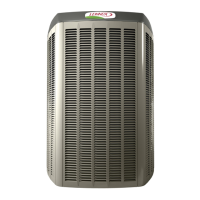Page 75
XP21
Unit Sequence of Operations
The following figures illustrated the overall unit sequence of operations along with various pressure switches and tempera-
ture sensor operations. The figures also illustration the use of the compressor anti−short cycle function in relations to unit
Status, Fault and Lockout LED Codes system operations interaction.
On 24VAC power−up or heat pump control (A175) reset, the heat pump control shall perform the
following tasks:
1. Start the anti−short cycle delay.
2. Check temperature sensor and pressure switches at the start of cooling demand.
3. Heat pump control responds to the thermostat input after the anti−short cycle timer expires. If there is
no thermostat input, control goes to standby mode.
Heat Pump control receives
cooling input.
The heat pump control (A175) will apply:
1. 24VAC to compressor contactor output Y1 OUT..
2. 24VAC to reversing valve output O terminal.
3. Output between 24 and 32 VDC on heat pump control’s
ECM fan terminals ECM Y1 FAN and ECM C.
NOTE − If low pressure switch is closed, system will ignore for
90 seconds.
The outdoor fan control (A177) will:
Receive the DC voltage signal from the outdoor control (A175) and
converted the signal to a pulse width modulation (PWM) signal. Jumper
settings will determine fan PWM OUT fan speed.
NOTE Refer to 17 for jumper settings.
1. For low (S87) and high (S4) pressure switches sequence of
operations, see figures 43 and 44.
2. For temperature switch RT28 sequence of operations, see
figure 45.
3. For Defrost calibration sequence of operations see figure 46.
4. For Defrost sequence of operations see figure 46.
Room thermostat calls for high (two−stage)
The heat pump control will apply::
1. 24VAC to second−stage solenoid output that will energized after the
first−stage compressor has been active for a minimum of five (5)
seconds.
2. Output between 24 and 32 VDC on heat pump control’s
second−stage ECM fan terminals ECM Y2 AND ECM C.
The outdoor fan control (A177) will:
Receive the DC voltage signal from the outdoor control (A175)
and converted the signal to a pulse width modulation (PWM)
signal. Jumper settings will determine fan PWM OUT fan speed.
NOTE Refer to table 17 for jumper settings.
Two−stage Ambient Lock−in Temperature
Should the ambient temperature be below the selected two−stage lock−in
temperature (jumper in place on jumper pin strip) , the two−stage solenoid
output will be energized after the one−stage minimum run timer expires
Energize two−stage ECM fan outputs ECM Y2 Fan and Y2 input/output.
Appropriate system status LED code is displayed to indicate two−stage heat
lock−in.
Room thermostat
calls for low (one−
stage)
Heat Pump control receives
heating input.
The heat pump control (A175) will apply:
1. 24VAC to compressor contactor output Y1 OUT..
2. Output between 24 and 32 VDC on heat pump
control’s ECM fan terminals ECM Y1 FAN and
ECM C.
NOTE − If low pressure switch is closed, system will
ignore for 90 seconds.
Figure 41. One− and Two−Stage Cooling Sequence of Operations (101796−XX Only)

